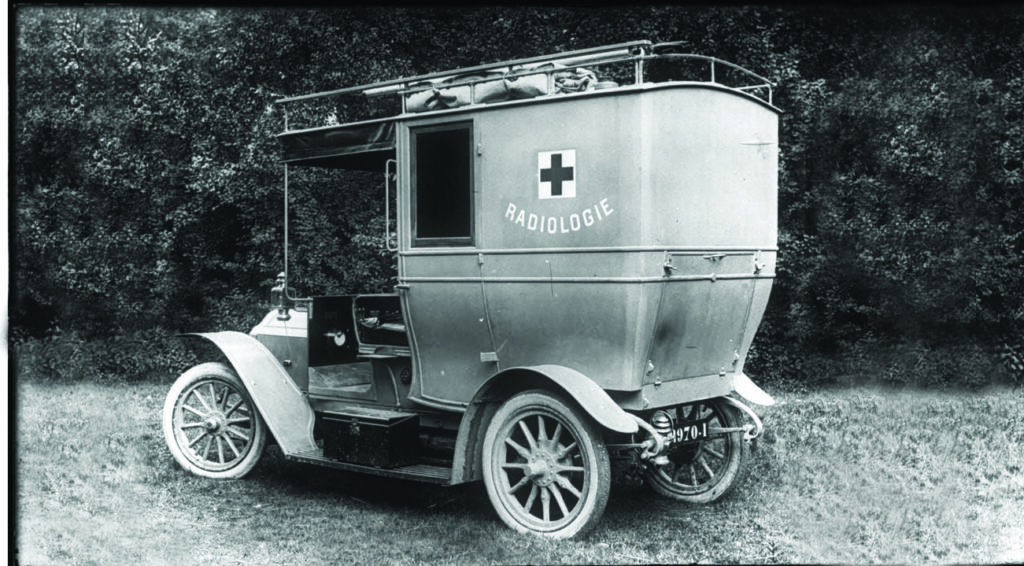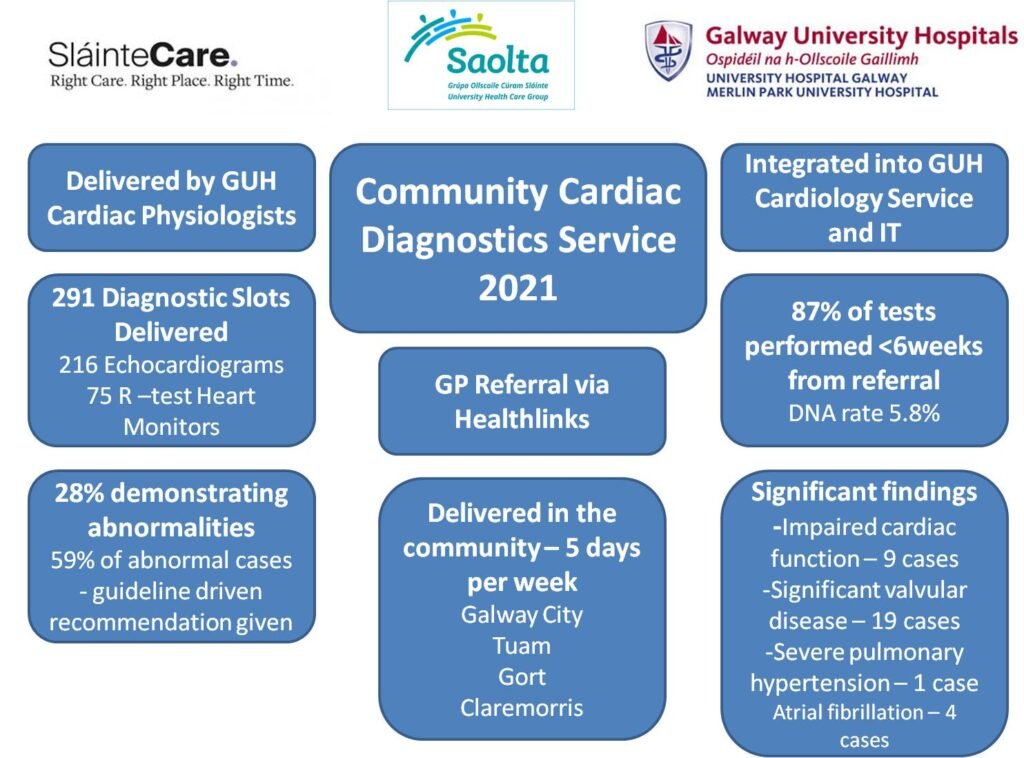In recent years in Irish healthcare, there has been focus on shifting more care into the community, closer to patients’ homes. This is reinforced in the Sláintecare Report and the intended approach is embodied by the ‘right care, right place, right time’ mantra. There has long been recognition of the difficulty that GPs have in accessing diagnostics. A report from the ICGP demonstrated that:
- <20 per cent of GPs have direct access to echocardiography;
- <25 per cent of GPs have direct access to heart monitoring (eg, Holter/R-test);
- 86.7 per cent of GPs agree or strongly agree that improved access to diagnostics would reduce their referrals to emergency departments (EDs).
Indeed, one of the effects of this lack of access to diagnostics is that GPs often have little option but to refer to outpatient clinics, with long wait times, or acute services such as the ED or Acute Medical Units. Direct access for GPs to diagnostics addresses these needs and meets the Sláintecare vision of shifting care appropriately, away from a hospital-centric model.
Mobile diagnostics are not new; indeed in October 1914 the first ‘petite Curie’, brought x-rays to the frontlines of World War I (Figure 1). Community cardiac diagnostics have been running in the UK for a significant period, with a positive impact for patients. It is reported that they prefer attending less stressful and more accessible clinics, and patient-reported experience measures are compelling. A similar community-based cardiac diagnostics service in Sligo demonstrated a saving of 250 bed days over a six-week period, by facilitating early discharge from hospital with follow-up diagnostics being delivered in the community.


Sláintecare Integration Fund
In 2019, all healthcare staff and organisations were invited to submit ideas to Sláintecare to access some of a €20 million Integration Fund. There was a particular emphasis on initiatives that would support the shift to community-based care and help to reduce and prevent hospital visits. The cardiology department in Galway University Hospital was successful in its application and received Sláintecare funding to commence its Community Cardiac Diagnostics Programme. This funding allowed us to purchase a portable echocardiography machine, of an equivalent standard to the hospital-based machine and 10 heart (R-test) monitors. It also covered the salary of a senior cardiac physiologist, who performs and reports the echocardiograms, and an administrative post.
The service currently operates from five clinics in Tuam, Claremorris, Gort, and two in Galway city. These sites are reachable by staff within 45 minutes, thus maximising the number of diagnostic slots available. The service is currently providing direct access for GPs to 40 diagnostic slots per week.
The service is provided by the team of cardiac physiologists, under the clinical support of the consultant cardiologists from Galway University Hospital, rotating out to the centres. The cardiac physiologists providing the service have internationally recognised accreditation in echocardiography. This combined with it being under the clinical governance of the hospital gives associated quality assurance.
The clinical support and governance of the consultant cardiologists is vital, in terms of their expertise for more difficult cases and continuity of care in referral pathways. All images and reports of investigations performed are archived to the hospital’s cardiovascular IT systems and uploaded to the hospital’s electronic chart. This ensures continuity of care in the case of referral to the hospital at a future date. It also ensures that tests are not repeated unnecessarily.
One of the initiatives the cardiology team worked on was to create a GP summary template for various findings. The aim of these was to translate what can be quite a technical echocardiogram report into a summary with clear guideline-driven recommendations; for example, in cases of mild aortic stenosis, with no calcification, we recommend to repeat the Echo in two-to-three years. The aim of this is to make it easier for GPs to manage the patient and their results. In the case of significant findings requiring more urgent referral, our cardiology team will arrange this with the GP advised of this.
Indications
Typical indications for echocardiography from primary care would include:
- Murmur
- Symptomatic murmur.
- Asymptomatic murmur with other signs suggestive of structural heart disease.
- Suspected heart failure
- Clinical signs of heart failure.
- Unexplained shortness of breath if ECG/CXR abnormal.
- With higher priority given to referrals with elevated BNP.
- Syncope
- With clinical suspicion of cardiac disease.
- Exertional syncope.
- New onset, rate controlled, atrial fibrillation.
- Palpitations.
The R-test monitor records a full heart rate trend and automatically records arrhythmias, including everything from ventricular ectopic to atrial fibrillation and ventricular tachycardia. Indications for R-test (similar to Holter) include:
- Syncope and presyncope, where it is unlikely to be vasovagal.
- Palpitations
Symptomatic and unlikely to be ectopic beats. Palpitations can be a troublesome diagnostic challenge and can cover everything from a patient being very aware of their heartbeat, to ectopic beats, to a significant arrhythmia. While a normal resting 12-lead ECG gives some degree of reassurance, the diagnosis is made by getting a symptom/rhythm correlation. It has been shown that 24-to-48 hour ambulatory monitoring has a relatively low diagnostic yield unless the patient has daily palpitations and whilst event monitors have a higher diagnostic yield, they are typically only fitted for a couple of weeks. New technology, such as hand-held ECGs, for example, the Alivecor device, have a high yield for a relatively low, once-off cost.
In the setting of palpitations, a normal echocardiogram can be reassuring. Where the nature of the palpitations has not yet been characterised, a normal Echo and a normal ECG would suggest no further management is required. If the palpitations were very frequent or distressing, referral could be considered.
Some signs, which would point to an increased likelihood of a significant arrhythmia, include:
- Symptoms at work;
- Exertional symptoms;
- Symptoms disturbing sleep;
- Known cardiovascular disease;
- Older age;
- On cardiovascular medication.
Service to-date
The Sláintecare GUH Community Cardiac Diagnostic Clinic has seen over 290 patient in the first two months of 2021, performing 216 echocardiograms and 75 R-test monitors (Figure 2). A total 87 per cent of tests were completed within six weeks of referral and over half were seen in two weeks or less. Over a quarter (28 per cent) of tests have a significant abnormality that would require follow-up, but in 59 per cent of these cases the follow-up could be left with
the GP, furnished with a recommendation in the diagnostic report.
Significant findings that required onward referral by the service directly included:
- Reduced left ventricular function;
- Significant valve disease;
- Severe pulmonary hypertension;
- Newly discovered paroxysmal atrial fibrillation.
Future direction
The service has been widely adopted by GPs with high levels of satisfaction from patients. It is leading to more timely diagnosis as outlined in the associated case study. One 85-year-old patient who attended our Gort clinic sums up the improved patient experience. She is reliant on taxis to take her to hospital appointments, which is an over 90km round trip and a taxi fare of €110. The ability to attend our community clinic transformed this to a five-minute trip. With such benefits in terms of wait times, earlier diagnosis, and improved patient experience – we are hopeful that funding for the service will be continued and perhaps expanded as community-based integrated care hubs are rolled out nationally.
This service is dependent on the support of the primary care centres, Community Health Organisations, Galway University Hospital management and the Saolta Project Management Office. The key element is the hard work and support of the team of cardiac physiologists, cardiac consultants and cardiology administration staff in Galway University Hospital.

References on request
